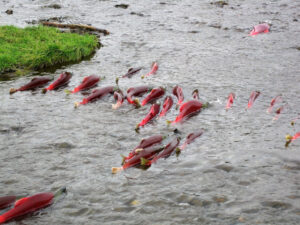Grade 3 - Rivers to the Sea and Back Again
SUMMARY
A 7-9 Week Science Unit for Intermediate Level
This unit is designed for 3rd grade, but could be adapted to other grades. Students develop knowledge of watersheds and the water cycle, as well as knowledge of the life cycle of salmon and the needs of salmon as they relate to watersheds. Activities include stories, discussion, a “crumpled-paper” watershed activity, a water cycle simulation game, collaborative research, and a field trip to a local water body to assess its potential to support salmon. Finally, students create and demonstrate a model of a healthy watershed. Language arts and art are incorporated into the unit, as are science notebooks.
Essential Questions
- How are we connected to wetlands, rivers and the sea?
- What is the salmon’s life journey through the wetlands, rivers and the sea?
- Where does our local water come from and where does it go?
Enduring Understandings
- Watersheds, rivers, wetlands, and the one big ocean of the world are an interconnected system.
- Salmon depend on the rivers and the ocean during parts of their life cycle.
- Science is a way to answer questions about the world around us.
LESSON PLANS

A Salmon’s Life Journey
Students investigate salmon life cycle stages and their relationship to parts of the watershed. They use cards to generate questions and ideas, and work cooperatively to research the salmon’s life journey through a watershed, answer the questions and gather evidence for their claims. They share and discuss their findings with the class, and demonstrate their knowledge by making posters.
View Lesson Plan
Fish Finders
In this investigation, students explore the needs of salmon at each stage of their life cycle, and then go into the field to investigate a local aquatic habitat and its potential as salmon habitat. They observe the physical characteristics of a local area and determine whether they think it is sufficient to sustain salmon. NEW! Fish Finders investigation aligned with the NGSS.” and link to the NGSS-aligned Fish Finders.
View Lesson PlanAUTHORS
Tom McKenna, Teacher, Juneau, Alaska
Terry Slaven, Teacher, Wasilla, Alaska
Jennifer Wardes, Teacher, Kasilof, Alaska
Marilyn Sigman, Scientist, Center for Alaskan Coastal Studies, Homer, Alaska
Stephanie Hoag, Curriculum Consultant, Juneau, Alaska
Marla Brownlee, Alaska Sea Grant
